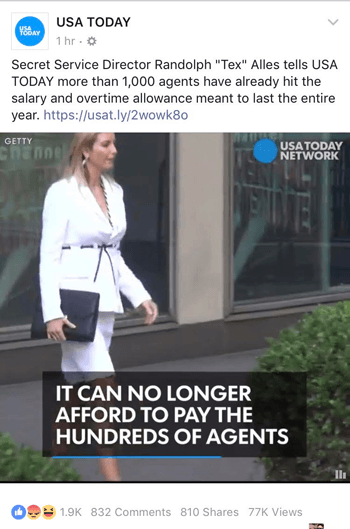On this Day: A Timeline of Facebook & Publisher Problems

When considering its audience reach and activity (1.9 billion monthly users), Facebook is the most important news-disseminating app/website today.
Facebook bears an incredible responsibility to its users (whether actively seeking news on their own such as following publishers or receiving it through ads or boosted posts); as information from publishers shapes our feelings and fears which are used to make decisions in nearly every aspect of our lives. On the other hand, Facebook is also a business with shareholders/stakeholders who require profits. Facebook would be - and is - wise to make business moves that keep people on their site or in their app longer, limit the audience reach of third parties looking to gain traffic or revenue from the network for free and require advertising dollars to show up in a targeted user's News Feed.  While the press is certainly free from government control and judicial punishment (in most situations) in the United States - free to publish the stories they see fit with the protection of the first amendment - publishers are limited on Facebook. The social media networks "own" publishers' audiences there and can deliver what they see fit to people who are using their services. The ramification of that, however, is that the 62 percent of people who get news on social media are seeing what algorithms want them to see. The publishers themselves also have to think if their delivery of news is ethical.
While the press is certainly free from government control and judicial punishment (in most situations) in the United States - free to publish the stories they see fit with the protection of the first amendment - publishers are limited on Facebook. The social media networks "own" publishers' audiences there and can deliver what they see fit to people who are using their services. The ramification of that, however, is that the 62 percent of people who get news on social media are seeing what algorithms want them to see. The publishers themselves also have to think if their delivery of news is ethical.
USA Today, for instance, has the right to acquire audiences for the purpose of subscriptions and advertisements. When using Facebook's "preferred audience" feature (which is noted by the gears next to the time stamp in the post on the right), however, USA Today is determining who sees news. USA Today could limit their posts to people with certain interests and even restrict people by age, location and gender. Therefore, reactions and sentiments to certain posts could be influenced by the type of affiliations who were targeted initially.
It can be argued that a person should choose what they see. In many ways people have indicated what news they want to see by liking publisher Pages, yet Facebook has made it nearly impossible for publishers to reach their whole audiences. Publishers' organic reach has dropped by more than 50 percent last year alone. Although it is not ever in a company's best interest to build their brand on another medium other than their website, people are getting their news on Facebook so publishers cannot abandon ship. Publishers have to fight to reach their audiences where they are, but how did we get here in the first place?
Let's explore some major developments over the decade that have changed the dynamic between Facebook and publishers - with news delivery hanging in the balance.
+ Sept. 5, 2006: Facebook releases News Feed, which would soon be the basis of most publishing activity on the network.
+ Nov. 6, 2007: Facebook launches self-service ads platform and Pages, which would help businesses (including publishers) build their brands on the network, set up the future where Pages are treated differently than profiles in terms of visibility and be the foundation of Facebook's increasingly pay-to-play business model.
+ July 10, 2008: The social media network launches Facebook for iPhone, which would lead to ever-increasing mobile usage and the need for publishers to have a mobile-friendly website after the click (something that would eventually be a ranking factor).
+ Feb. 9, 2009: Facebook introduced the "like" button, which would serve publishers well in many ways such as being able to measure engagement (until more advanced indicators came along) and have stories spread organically when readers' friends saw their activity on Facebook.
+ Sept. 22, 2011: Facebook releases Timeline, which would keep stories that people have shared around indefinitely (without manual intervention) and add more staying power to both personal posts and ones shared from third parties like publishers.
+ Jan. 16, 2014: Facebook announces Trending - a collection of popular "conversations" and stories - which was a big step for Facebook to influence what people see. Trending would eventually come under fire for employees manually suppressing topics even if they were organically trending.
+ March 2014: A study from Edgerank Checker found that between February 2012 and March 2014, organic reach for the average Facebook Page dropped from 16 percent to 6.5 percent ( source).
+ Jan. 20, 2015: Facebook starts to crack down on hoax news stories, giving users a way to report them. Satire sites or those with opposing views, however, could see negative effects as an unintended consequence.
+ April 21, 2015: Facebook updates its algorithms based on its understanding of who users care about and what Pages too based on how often they interact with those people or Pages. There is starting to be chatter about Facebook becoming an all-paid network for Pages.
+ April 29, 2015: Forty million active small business Pages are on Facebook, which means more content and a growing concern by Facebook to control the News Feed.
+ May 12, 2015: Facebook's biggest step into publishing is released in the form of Instant Articles, which would speed up the reading experience because articles are read directly in the News Feed. This would also mark the start of one of the biggest fights with publishers who were unable to paywall content and would receive less website traffic if enabled (as there's no reason to continue to the publisher's site).
April 6, 2016: Facebook Live is released to everyone and so begins the network's love affair with live streaming as it was known that Live videos were given a boost in rankings. Practically from this day on, publishers would need to use video to compete for visibility.
+ April 21, 2016: Facebook updates its News Feed ranking to predict how long users will spend looking at an article in the Facebook mobile browser or an Instant Article after they clicked through from the News Feed. Facebook expected some Pages to receive small increases in referral traffic and others to see minor decreases.
+ June 3, 2016: SocialFlow found that among 3,000 publishers, organic reach per post dropped 42 percent between Feb. 2016 and June 2016 but would later update that figure to 52 percent.
+ June 29, 2016: Facebook announces it will prioritize friends' posts over Pages - another possible blow to organic reach.
+ Aug. 4, 2016: Facebook further reduces clickbait in the News Feed by identifying common words used in clickbait titles (similar to how an email spam filter would work). From an editorial standpoint, however, credible publishers also used this language to earn engagement since they were experiencing low organic reach.
+ Aug. 11, 2016: Facebook kicks up its personalization efforts by combining different factors to serve up relevant stories to its users (e.g., their relationship with the publisher that posted, what they might click on, etc.). Publishers, in this case, are at the mercy of algorithms. Facebook offers the same advice as many other news room announcements:
"We anticipate that most Pages won't see any significant changes to their distribution in News Feed. Some Pages might see a small increase in referral traffic, and some Pages might see minor decreases. Pages should continue to post stories that are relevant to their audiences and that their audiences might find informative."
+ Dec. 5, 2016: Facebook allows users to flag "Fake News" stories and provides them a warning that what they are about to read may not be true.
+ April 25, 2017: Facebook began testing Related Articles to provide complementary content under a link shared in the News Feed. Even so, Facebook did not expect this feature to impact a Page's reach.
+ May 10, 2017: Taking a page from Google's book, Facebook announces it will reduce links within the News Feed to low-quality websites (undefined at this point but likely speed, time on site, low bounce rate, etc.).
+ June 28, 2017: After initially targeting publishers with a separate test (to combat fake news), Facebook widely removes the ability to customize link metadata (headline, description, image) from all link-sharing points. Instead, Facebook crawlers take their best guess on what should appear, which often makes for a low-quality post. Facebook said it will work with publishers to "understand why editing link previews is important to them." Publishers can also use Open Graph to install tags on their website to better control the content that is displayed.
+ June 30, 2017: Facebook will now limit the amount of shared links users see from their friends who tend to share frequently. In other words, they are limiting the influence of friends in the News Feed, not just Pages.
+ July 20, 2017: Facebook provides a six-month update on its recently launched Journalism Project. Within the statement, Facebook indicates it has met with 2,600 publishers to create dialogue with them and that Instant Articles now pays out more than $1 million per day to publishers via Facebook Audience Network.
+ Aug. 2, 2017: Facebook more clearly defines what a low-quality website is by announcing it will make an update to News Feed to show people more stories that will load quickly on mobile and fewer stories that might take longer to load.
+ Aug. 17, 2017: Facebook announces that during the coming weeks it will begin demoting stories that feature fake video play buttons and static images disguised as videos in News Feed. It is not uncommon for reputable publishers to share a screen grab from a video with a link to their site. This update will keep users on Facebook versus following a link to watch a video.
+ Aug. 22, 2017: Facebook announces it will begin introducing publisher logos next to articles in Trending and Search. Publishers will now be able to upload multiple versions of their logos through a new Brand Asset Library, so that the logos can appear next to their content on Facebook (to help consumers retain the source of the information they read).
Stay tuned...we will keep this "#PublisherProblems" page updated as Facebook rolls out algorithm updates that negatively or positively impact publishers' ability to reach their audiences on the social media network. Last updated at 2:15 p.m. PT on Aug. 22, 2017.

Subscribe to Our Newsletter!
Latest in Social Media










